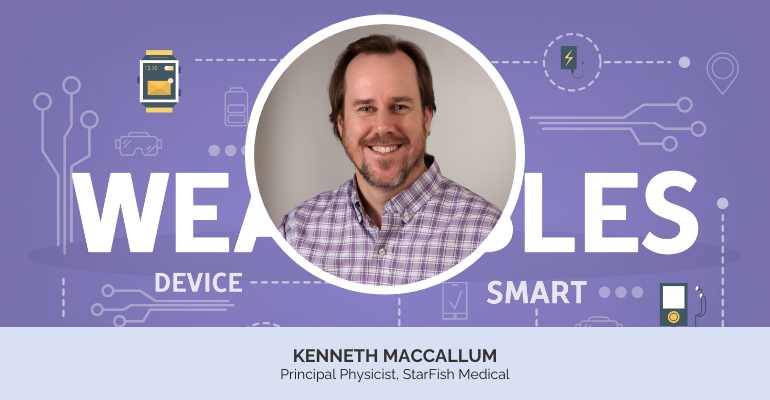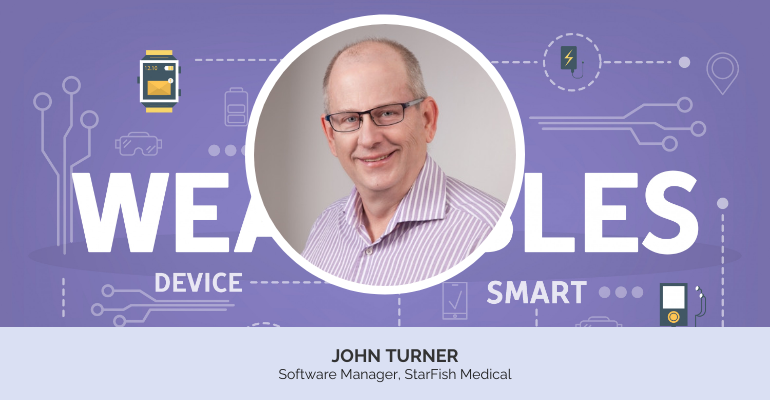Wearable Medical Devices: What Do Design Engineers Need to Know?
Interest in wearable health technology continues to rise significantly, according to many reports. Health and fitness monitoring continue to drive demand, and emerging needs such as remote patient monitoring, home healthcare, and drug delivery could add to such interest. To help medtech product designers meet these needs and more, MD+DI asked a group of medical device engineers about the latest developments in wireless technology, battery life, data and security concerns, user needs, and more. The following questions were discussed and collectively answered by a team of engineers from StarFish Medical. These engineers are Kenneth MacCallum, principal physicist; James Jackson, principal industrial designer; and Nigel Syrotuck, mechanical engineering team lead. Also contributing are John Turner, software manager; and Ash Luft, embedded software engineer. Read on for their insights on wearable medical devices.
How has wearable medical device usage increased in the last five years?
Fitbit, Apple Watch, and insulin pump usage have all increased in popularity and usage. The insulin pump, hearing aids, ECG, and continuous glucose monitors are on the market and are considered wearable medical devices. Diabetes wearables are going to become very common when glucose monitors and pumps are added to the mix and provide a level of constant care.
We saw a big increase in client requests for wearables a few years ago. Recent projects include pain cessation, insulin delivery, and post operation follow-up.
How will fitness monitoring shape the global wearable medical devices industry?
Fitness monitoring is more popular than ever. As a result, a lot of people are learning how a wearable works, setting the stage for medical devices. Apps are also more ingrained in everyday life, like the Apple Watch monitoring cardiac arrhythmia, cardiac arrest, and general health. Healthcare professionals are beginning to tap into apps for constant monitoring and emergency monitoring to determine [whether a patient is] having a heart attack. They’re not there yet, but the long game is to make fitness monitoring devices and apps into regulatory accepted medical devices.
One obstacle to overcome is that although Fitbits initially seem very cool, the value they deliver to their users is pretty limited. People buy them, use them, and then get bored. In our opinion that’s because right now they are more about serving big data than the individual, although their hope is to also improve lifestyles and provide users with biometric feedback via ECG monitoring, blood O2 monitoring, and the typical IR sensor. Fitbit is working to add clinical indications to their devices as well as experimentally aggregating data broadly among their user population to draw medically relevant conclusions. Until they provide direct clinical value to individual users, it is unlikely that adoption will jump up a level. In the meantime, being able to read texts on your wrist is probably more useful and more reason to wear a device than seeing if you walked more than 10,000 steps in a day.
 How can diabetes care applications challenge the wearable medical device industry?
How can diabetes care applications challenge the wearable medical device industry?
Diabetes care applications are a very big market for wearable medical devices. We see a big uptake on them. People want them. They wear them. You see them all around now on both kids and adults. It’s a real medical device, really wearable, with real benefits, and being used and improving the quality of life in many ways.
How are current wearables adhering to customer needs and wants?
They’re combining things to promote adoption. A smartwatch has to have things like text messages for people to really like it. The purely pseudo medical part is often not so compelling. Wearables is a very buzzy topic, but it feels like killer applications are few and far between in the medical space.
Currently, the most adoption is in the performance fitness stuff—the people who ride their bikes a million miles a day and want to track their heart rate over six months to see how they’re doing. Apple is not just looking at the Fitbit side. They want more integrated health. Their Apple Health app is primed for a lot more than just being a step counter or tracking peak and resting heart rates.
If we can broaden wearables to include things like phones, then a bunch of interesting things are happening with apps. Particularly with COVID and all the COVID apps that people have on their phones.
Contact tracing is being used in Europe and trialled in North America. It’s a wearable, but just monitoring where people are. Ironically that’s the sort of data that if Google or somebody similar said, “Hey, we just happen to be tracking you and noting whenever you show up near one of our other customers,” it would be creepy. But now, suddenly it is acceptable, even appealing.
The COVID tracker is very relevant in the times that we’re living in now. And those times are way different than they were five months ago or six months ago. That’s a wearable medical device of sorts. Finally, a compelling use case for a wearable. The implications are obvious. The technology is not insurmountable. You have to be beside somebody for five minutes and you have to be within two meters for five minutes for it to work.
Another example can be seen in orthodontics. The daughter of one of StarFish Medical’s engineers uses an electronic device that she sticks in her mouth for a number of minutes every evening. It helps make her teeth move and the orthodontist says, “if you don’t do it, then it may take longer and cost more.” The upside for the patient is “faster and costs less if you do these things.”
Also, there’s a big issue with incorrect dosages or incorrect medicines being given. Wearables can help for insurance reasons and also prevent the wrong medication being given. Apple Health enables you to take a picture of a drug or a tablet and find out what the drug is and how many milligrams are in the tablet. Your phone can take a photo of pills that are about to be administered and give you a second line of assurance, thereby reducing incorrect dosage incidents.
A similar device is the pill tracker. A number of phone apps are connected with special pillboxes to help simplify complex medications. They ensure pills are taken at the right time. And they don’t forget. The clinician gets to see how well the patient has been taking medications and can make a proper diagnosis.
The Holy Grail of medical device wearables is a combined insulin pump and monitor, because monitors currently send us a fingerprint every now and again. Real-time monitoring of what’s happening with fidelity through the day in a combination version that will dispense insulin in more of a considered way will dramatically improve healthcare for diabetes.
Long-term blood pressure monitors that you can wear for 24, 48 hours or a week are the thing now. There’s one for estrogen as well for pregnancy, for monitoring the menstrual cycle and identifying the optimal time to fertilize the eggs. Several monitors based around estrogen are coming on market for all the reasons above.
 What technology has made the biggest leap for wearable medical devices?
What technology has made the biggest leap for wearable medical devices?
Every wearable now interacts with, and usually uses, the cell phone as the hub of all communication because everybody has one. If it’s a smartwatch, it talks to your phone, Glucose pumps have an interface on your phone. As phones and other wearable tech march forward, wearable medical devices are going to build on them and benefit immensely.
Another area is sensors. For example, integrated directly into the knee, a prosthetic can monitor temperature, position spaces, and rehabilitation. The bend sensor can show a physiotherapist whether their patient is actually holding to their rehabilitation regime. Or, the sensor can indicate that if there is an infection. They communicate directly back through a phone. Often the rehabilitation system is designed to gamify the experience in order to encourage compliance. This system enables a health provider, which is essentially the insurance company, to confirm that a patient is actually doing rehab.
What are the current limitations of technology for wearable devices?
Battery life is a limitation. There hasn’t been a huge step forward in battery tech for a while. The amount of energy you can jam into a given volume has been the same for a few years. We’d love to see that jump forward a bunch. A lot of battery development is currently going on for a variety of reasons. Maybe we’ll see a big jump in the next decade.
How can recent wireless trends for wearable medical devices benefit healthcare providers?
Everybody has a phone. The more people who use a wearable connected to their phone, the more data available to collect either anonymously, or with permission, on a person-to-person basis.
The cell phone is a bridge between a medical device and the cloud. One can link a wearable monitor to the clinician through the cloud. There’s no IT problem to solve to allow that to happen because the Internet is available all the time.
A cell phone is useless without wireless, as apps on it allow communication to the cloud and capture of data, but then, of course, it’s got to have a short haul wireless like Bluetooth, which allows you to go to sensors.
If the patient is wearing a device, there’s a more longitudinal measurement of whatever parameter their wearable might be monitoring. Rather than taking punctuated tests, providers get a whole bunch of data. Although not much is on the market yet, the industry talks about the potential of long-term data.
We don’t know yet if the COVID tracker is effective, but everybody seems to think it’s worth trying. Perhaps that’s just because we have a phone in our pocket and can do these types of things. It is definitely a benefit for healthcare providers who can track contacts much better.
More efficiency and patient access to health records are also a benefit. A phone can scan bar codes either on patients, on the drugs, or both. Wireless communication between a phone and other wearable devices empower and streamline information and workflows for providers and patients.
On the compliance side, healthcare providers can make sure their patients are doing the things they are supposed to do. However, there is a potential downside that insurance providers could make decisions that aren’t best for the patient based on data that they receive from wearables.
 How are wearable devices benefiting patients?
How are wearable devices benefiting patients?
There are two aspects to wearables that could benefit patients. One is removing decision-making from the clinician, allowing the cloud to make that decision. The other is monitoring people to make sure they’re doing what they’re supposed to be doing.
It’s a double-edged sword. The upside is, we’re all human and mess up periodically. Wouldn’t it be great if we had this little angel overlooking over our shoulder and saying, “Not that one—take this one?” Let’s face it, it’s usually the stupid things that we fail at, not the complicated things. We pay attention to the complicated things.
Patient benefits are empowerment and the ability to see what’s happening in their bodies in a way they’ve never been able to see before. Professionals may have been able to see what’s going on in patient bodies, depending what the patient is hooked up to, but this is the first almost real-time monitor on what’s happening. The ability to put his or herself under a microscope is quite an interesting patient benefit. It can enable more adherence to plans while removing the veil of what’s in the doctor’s chart. It gives more clarification about “what professionals are writing down.” Add in the gamification when the patient can see their chart, they can go, guilt or gamification.
Patients are able to monitor their progress and see that they’re progressing. They can also see how altering their routines might help them more. It’s a long-term understanding of what they’re doing and how it’s working (or not). The healthcare provider can contribute to this effect if they have access to the data and can advise the patient on what is working and not working and then adjust accordingly.
What are the wireless trends?
Bluetooth through phones is a big trend. Wires don’t plug into phones much anymore. The same thing is happening with medical devices. The phone app for a glucose monitor or insulin pump uses Bluetooth. Wiring a link to a phone to be able to control a device would be really irritating. People don’t want big and bulky wearable devices, because their phone has an awesome portable, wearable, rich user interface already.
A common or known interface back to an Android, Apple, or other platform and being able to integrate into that holds a lot of benefits. They are known interfaces comfortable for users which other design guides are asked to uphold. That commonality reduces error and increases adoption. It’s a much richer interface for developers to develop on compared with building and supporting new hardware.
Hearing aids and cochlear implants now use phones as an interface to tweak their parameters. Five years ago, to change the parameters of a hearing aid, users had to go in to a clinic. That was partly the business model, but now hearing aids allow users to tweak devices and change the settings to adjust to the environment—TV mode and things like that. Users pay a monthly subscription instead of a clinic visit fee.
What are the most reliable forms of wireless communication for wearable medical devices?
Bluetooth and Bluetooth LE are both good options. Every smartphone has Bluetooth capability so we can connect that way. Some cell phones have near field communication (NFC), although it’s not super useful for wearables. The phone itself has Wi-Fi and cellular data to communicate up into the cloud where the data can be passed on to clinicians in an appropriate way.
How have wearable medical device designers handled limited power sources?
Bluetooth LE is good because it is low power. Mostly, designers trade bandwidth for power. If users do not need to send much data and send it infrequently, then a skimpy battery is great. Aggregating data and sending it up in small little bits rather than a massive unprocessed data stream can be a way to handle limited power sources. Sleep modes and reduced functionality are additional options.
Batteries are getting better, but there hasn’t been any step change in power densities since lithium, lithium ion, and lithium polymer. They are the most energy dense, most readily available power sources. There other battery technologies such as mercury batteries, silver oxide etc., but lithium chemistries are by far the most prevalent for wearables. Lithium ion batteries have safety issues around them, but there are lots of standards to keep it safe.
How have technological advancements impacted wireless communication for wearable medical devices?
Technological advancements have focused on a very small number of mechanisms, lower energy communications, higher energy density batteries, and in particular, the cell phone. Everybody has a cell phone. A decade ago, designers might have considered putting an SMS transmitter-transceiver in a device to ensure that connectivity. But with Bluetooth on most phones, designers can pretty much assume the phone can get any comms that are need There may be cases where somebody doesn’t yet have a smartphone but needs a medical device with connectivity. It’s likely they will need a loaner device. Communicating through a phone is so compelling because it is so available for most of the population.
 How do wearable medical devices transmit and receive data from controllers or smartphones?
How do wearable medical devices transmit and receive data from controllers or smartphones?
Bluetooth LE is certainly a way. There are more proprietary methods to communicate through tissue. But mostly the jump to a phone is done with Bluetooth. NFC is about the only other way to transmit and receive data, but not every phone has it.
How do you balance security and utility in wireless wearable medical devices?
It would be great to send all sorts of great data across all these wireless links, but the more data, and specifically the more patient identifiable data that you send, the more care you have to take to not let the data get away from you and to not let it get outside of your control.
Another balance is ease of use. If you want the process to be simple for connecting and throughout its use, the solution often leads to less security. Ensuring a lot of security often means lots of hoops to jump through, such as passwords to type in or biometric biometrics or whatever. The balance is ease of use versus keeping data secure. Fortunately, technology is marching on. Cell phones now have fingerprint sensors and lots of apps now use the fingerprint sensor as a security feature. If everybody has this on their cell phone, that removes the need to type in an onerous password and write it on a Post-it on your fridge or something like that.
A lot of data breaches happen with people getting into the server at the facility, not by getting into a phone. Why not get 10 million hits instead of one at a time? Regardless of whether there is a secure link to get the data into the repository, or kept the link to the database secure, somebody can hack into the database and get tons of data instead of data for just one person.
How has security technology for wearable medical devices changed?
In the past 5-10 years, we have seen an unprecedented explosion of connectivity integrated into technology including wireless and wearable medical devices. Ensuring clinical environments have secure networks has already been a major issue for health delivery organizations historically. With the shift towards wireless wearables, more devices are operating on consumer home networks or even public Wi-Fi. Increased connectivity means that devices may be exposed to unknown or unsafe networks, which may significantly impact risk.
People are taking it seriously. There have been enough instances of things being hacked, whether they are pacemakers or insulin pumps or another device. These hacks demonstrated how insecure wearable medical devices were. The industry and patients now understand security is something that they can’t ignore. That’s a big change. We have got to worry about cybersecurity. It will be very public if you don’t pay attention. A number of medical device manufacturers have become quite public regarding how they’ve been hacked or discovered a vulnerability.
If you look back far enough, some wearable devices didn’t use wireless technology. They didn’t need security because it was just one person’s data on an old school pedometer or an insulin tracker. Security concerns might have been a little bit different. But now, we want wireless data, constant connectivity, and telemetry. We want a cell phone app. Wireless security is valuable to the company that makes the device, consumers, and healthcare providers.
The challenge is to provide patients and clinicians with the richest interface, the most useful data presentation, with the least amount of passwords required, and then making it secure so nefarious actors can’t come along and hack a pacemaker, turn it off, or grab health data that they can use negatively.
What security implementation challenges does the wearable medical device industry face?
One class of challenges stems from security industry solutions being designed for hardware independent software or non-safety critical systems. For example, standard security tools and protocols that work well to assess modern web applications or traditional networks often aren’t appropriate for embedded devices and product life-cycles that include hardware-dependent development. We need to create custom solutions to address the security requirements for each device which can be resource intensive.
 If you were creating a wearable device, what you raise as key considerations and why?
If you were creating a wearable device, what you raise as key considerations and why?
Fitting a wearable onto a user is always a huge thing. And that’s not just the size of the wrist, but how hairy their arm is and how loose their skin hangs. What impact will the wearable have on their day-to-day life that may cause them to either use it, or not use it, or use it improperly?
On the projects that have a wearable aspect, those are the big challenges we have to get through. We can leverage a lot of the wireless communication from consumer electronics. But to make it fit onto a person, into a person’s life, and interface with them in a way that makes it, is going to continue to be a big challenge.
Sensors are part of that. There is no sensor out there that can be bought off the shelf for a reasonable price that will actually work for most people every time. Maybe it skips a couple heartbeats or whatever, and the data gets thrown off. We can try to fix it with an algorithm, but things are a little wishy-washy. Sensor technology is good, but not great across the board.
How these wearables are worn is a challenge. There is some stigma as well. That’s always been the challenge. A shortsighted view is “make it look like an Apple thing.” People with IBS don’t really want to be going around with anything, regardless of how nice it looks. Other concerns are how and where it adheres to the body, comfort, and lots of problems with temperature. If you’re down in South Carolina wearing one these wearables around your midriff, you are probably very uncomfortable.
And then there is the issue of acceptance—are people psychologically comfortable wearing these things? That’s why fit people don’t wear Fitbit. There’s a lot of psychology involved with wearables. We don’t fully understand that yet. What’s going to work? At the moment wearables are kind of like the Apple Watch, your Fitbit for their kind of things that can’t be seen. How that will playout in the public psyche is going to be very interesting. Is it something that will be, “Oh, look, what I’ve got.” Or is it something that people will be more quiet about wearing.
The difference between a smartwatch and a wearable medical device is that a medical device represents a condition. There’s an issue that you’re trying to solve or detect, and that’s why you’re wearing the device. Whereas, a smartwatch could be just a cool fashion accessory. You might like people to see your smartwatch. You probably don’t want them to see your colostomy bag.
What stood out for each of you after all your discussions on wearables and wireless?
Syrotuck: Perhaps it’s a little pessimistic, but I think there’s been no fundamental shifts in the way wearables and wireless work in the last five years. It’s definitely a lot of work. Anyone who thinks that tossing a pedometer in a phone or a watch and sending the information to a Web site or an app is easy is missing some of the key technical challenges that come with medical devices. A. It’s tougher than you think and B. There’s nothing too new and exciting happening.
MacCallum: Really compelling medical devices are few and far between—insulin pumps, hearing aids, ECG-like applications. Not many of the Fitbit and fitness trackers are turning out to be a real thing as far as medical devices are concerned. A lot of people thought, if I designed an awesome sensor that I could “medicalize” and hook up to the cloud, then people will beat a path to my door. But they’re not. It seems like everyone is waiting to have that little epiphany of a new intended use that needs a wearable.
Syrotuck: Or one that works so seamlessly and requires so little of your mental effort. Like, if I could wear a watch that gives me data throughout my entire life and I knew that, in 40 years, I could take it in to my doctor and s/he could say, “oh, when you turned 60, that incident was nothing. But, you know, when you turned 40, it looks like you had a little heart attack.” That’s good to know. There’s also a hump of usability where if we can make things seamless and show positive effects over the long term, that’s the place we should go.
Jackson: This is kind of a looking glass into oneself with all the psychological responsibility that will bring. Constant tracking, being able to look at what’s happening with yourself instead of a doctor writing down something on a medical record, and you not knowing what’s there. Or not really understanding what they are saying about your blood pressure and every few months going in and talking again. This real-time information may empower people to actually take more care of their health. We’ll have to wait to see what actually happens, but I think that’s somewhat of a possibility.
MacCallum: Various healthcare schemes all over the world will need to adapt a lot to make that work. Unless the preventive-style care happens, not many healthcare systems are set up to really leverage that data. Nor does the way that clinicians get paid mesh well with some of the ways that we imagine wearables could be useful. If there’s no money in it, and they can’t recognize an immediate cost savings or an immediate revenue stream, it doesn’t matter how good a wearable might be for humanity—it will have a little bit of a hill to climb to get on the market.
ctor asks me, “Hey, are you wearing one of those bits yet?” Or maybe there is a screening question in the doctor’s offices, “Do you have any health tracking wearables?” will be the day that I think they are adopted and they are useful. That will be the day we’ve gotten there.
MacCallum: Especially if your doctor recommends, “Oh, you should get a smartwatch because, that’ll help me.”










